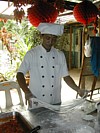|
noodle
A word derived from German and meaning
‘strip of pasta’. The
noodle reached Thailand along the ancient trade routes from
China, where it
originated. Noodles are today the second most significant food dish, next to
rice, and may be
consumed boiled as a soup with meat or look chin plah (fish balls), stir fried in a
wok with other ingredients or simply boiled and doused with a
curry. Noodle
dishes come in a large variety and the basic noodle is in Thai called either
guay tiyaw (rice noodles),
kanom jihn (soft boiled -curry topped- rice noodles),
wun sen (jelly noodles) or
bamih (egg noodles
-
fig.), depending on the kind,
which in addition may be specified according to its shape, e.g. sen
bang (เส้นบาง) for thin or flat noodles, sen yahw (เส้นยาว) for long
noodles, etc. Besides being a popular dish at local food
stalls it also appears in dried form in shops and supermarkets all over the
country (fig.),
and several new brands of instant noodles have hit the market over the
last decade. Today
Chanthaburi
is Thailand's foremost production centre for dried rice
noodles which are therefore often referred to as guay tiyaw chanthabun,
whereas Phitsanulok is famed for its
mih sua.
Instant noodles (fig.) are in most cases referred to as mama (มาม่า),
after the most commonly known brand, a trade name that has
subsequently passed into general use for most, if not all, instant
noodles (fig.). The most recognized noodle dish is probably
phad thai (fig.).
In China, the city of Lanzhou is known as the City of Noodles, and
is especially known for its beef noodles, which are famous across
China and are served in soup with radishes, hot sesame oil and
sliced beef, prepared with more than ten different spices. Also
popular all over China is chao mian (炒面), a dish of ‘stir-fried
noodles’ of which there are many varieties. The word chao literally
means ‘to pan-fry’, whereas the word mian is a measure word for flat
and smooth objects. The largest kind of Chinese noodles are found in
a dish known as Liang Pi
(凉皮), literally ‘cold skin’. These
noodles, made from wheat or rice flour and served in a flavoured
sauce, are obtained by letting starch from dough saturate in water
and left to rest overnight at a cool place, to allow the dissolved
starch to solidify and precipitate into large flaps, which are
reminiscent of rawhides. 回






|

